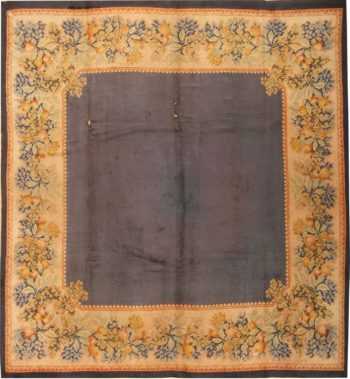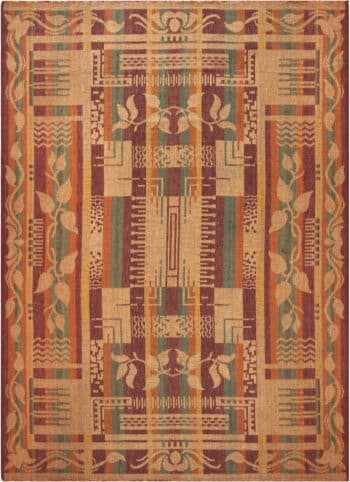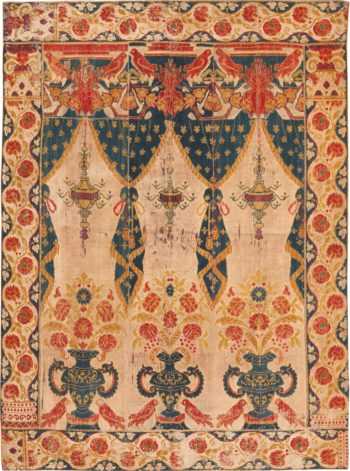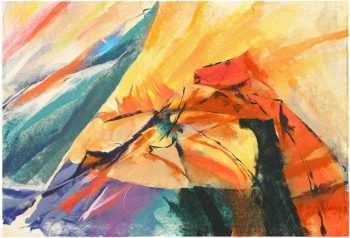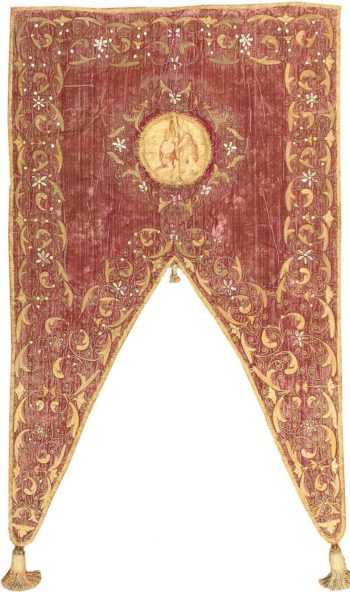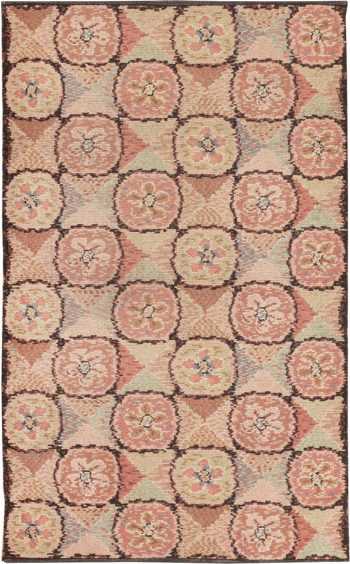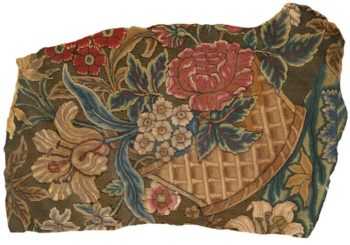European Rugs
View our current selection of antique European rugs below:
Open Field Antique Continental European Rug 72398
$7,200.00Size: 11 ft 8 in x 12 ft 9 in (3.56 m x 3.89 m)Vintage European Art Deco Kilim Rug 72828
$14,500.00Size: 9 ft 4 in x 12 ft 6 in (2.84 m x 3.81 m)Purple Vintage German Continental Rug 70927
$14,500.00Size: 8 ft 2 in x 11 ft 8 in (2.49 m x 3.56 m)Long And Narrow Antique Greek Embroidery Textile 41486
$5,600.00Size: 1 ft 8 in x 10 ft 9 in (0.51 m x 3.28 m)Antique Greek Embroidery 47221
$3,400.00Size: 2 ft 2 in x 9 ft 7 in (0.66 m x 2.92 m)18th Century Antique Velvet Wall Hanging Dutch Textile 70854
$21,000.00Size: 6 ft 3 in x 8 ft 6 in (1.9 m x 2.59 m)Antique European Silk Velvet Textile 41491
$3,600.00Size: 2 ft 2 in x 7 ft 11 in (0.66 m x 2.41 m)Vintage Tapestry Rug “Horses in Gale” by Ana Piksiades 48165
$9,600.00Size: 4 ft 8 in x 6 ft 10 in (1.42 m x 2.08 m)Antique European Embroidery 3391
Size: 3 ft 2 in x 5 ft 9 in (0.97 m x 1.75 m)Rare Collectible Antique Greek 17th Century Embroidered Textile 41489
$6,900.00Size: 1 ft 2 in x 5 ft 1 in (0.36 m x 1.55 m)Beautiful European Vintage Art Deco Rug 2609
$4,200.00Size: 3 ft 4 in x 3 ft 11 in (1.02 m x 1.19 m)Antique Wool And Silk Scottish Needlepoint Textile Art Sampler 46055
$2,200.00Size: 2 ft x 3 ft (0.61 m x 0.91 m)Small 17th Century Antique German Biblical Tapestry Depicting David And Abigail 72010
$8,500.00Size: 1 ft 8 in x 1 ft 8 in (0.51 m x 0.51 m)Antique European Needlepoint Fragment 40910
Size: 1 ft 9 in x 1 ft 1 in (0.53 m x 0.33 m)
Beautiful Collection of Antique European Rugs
European Rugs – The art of rug-making, while traditionally associated with the East, is in fact a global practice that has been ongoing for centuries. Indeed, the history of rug-making in Western Europe is a rich and fascinating story, just as much so as the history of the manufacture of Oriental Rugs. For instance, the history of rug-making in France (one of the first countries in Western Europe to manufacture rugs on a wide scale) is especially compelling. In France, the manufacture of rugs and carpets was initially undertaken by those in service of the King. The Royal rug-makers were commissioned to weave fine pieces beginning under the reign of Louis XIV, known to history as the Sun King.
It would be quite difficult for someone to overestimate just how influential Louis XIV was. Especially his long-lasting impact on French style and sensibilities. It was at this time, during the middle of the eighteenth century, that the Savnonnerie style emerged, as the Royal rug-makers crafted ornate pieces to suit the King’s taste for the elaborate and richly decorative. It was also at this time that the Aubusson style first made its debut on the world stage, crafted as an alternative to the Savonnerie that might have more appeal to a wider range of tastes; rather than being manufactured explicitly for the King, Aubusson rugs were woven to be purchased and to be enjoyed by the French people, especially the French aristocracy.
Shortly after the introduction of the Savonnerie and the Aubusson styles to the world, there was a marked uptick in interest in fine rugs throughout Europe. Suddenly, new styles were emerging throughout the Continent, and the rug-weaving industry was growing rapidly. Soon, the needlepoint embroidery, a European adaption of the from the famed Persian rugs, would emerge. In the following decades (and, ultimately, centuries) a great variety of distinctive European styles of rugs would emerge, solidifying the new European penchant for manufacturing beautiful carpets.
Learning about antique European rugs
History and Evolution of Early European Carpets
Although examples of knotted carpets were known and produced in the classical world by late Roman times in Egypt, they do not seem to have been part of the larger Roman heritage that passed down to Medieval Europe.
Once the emerging Islamic Empire conquered Egypt in 642, thereby cutting it off from the late Roman or early Byzantine Empire, rugs disappeared from European material culture, with the exception of Spain, which was conquered by the Muslims in 711.
We have no direct evidence for rug production in Early Islamic Spain, but it seems certain that its rulers would have had access to the same sorts of carpet current in the rest of the Islamic world at this time.
Fragments found in the rubbish dump at Fostat in Cairo have in fact been identified as early Spanish Islamic carpets of the eleventh to fourteenth centuries. Spanish production is attested much more clearly from the fourteenth century on, in the period of the Reconquista when Christian Spaniards recovered control of the Iberian peninsula.
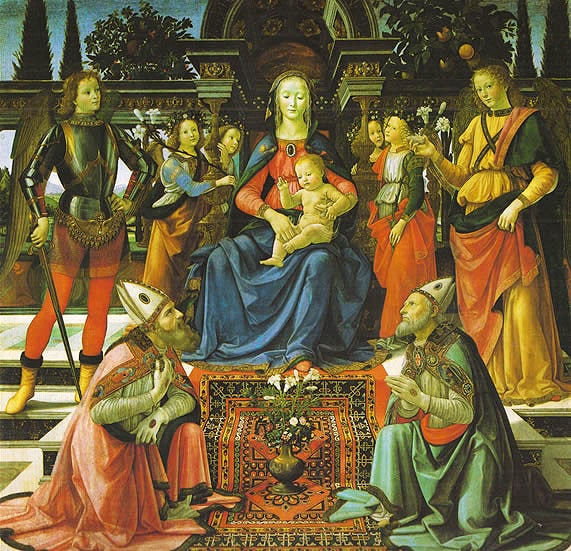
Depiction of the enthroned Madonna with a ‘Ghirlandaio carpet’ beneath her feet, Domenico Ghirlandaio, mid 15th century, Uffizi Gallery, Florence (from V. Gantzhorn, Oriental Carpets, ill. 482).
Surprisingly though, these late Medieval Spanish carpets still followed the design of Oriental models, especially the Holbein and Crivelli Star patterns of Ottoman Turkey, or the small-scale allover designs of Islamic silk textiles.
After the final expulsion of the Muslims from Spain under Ferdinand and Isabella in 1492, Spanish carpets evolved in more purely European or western styles.
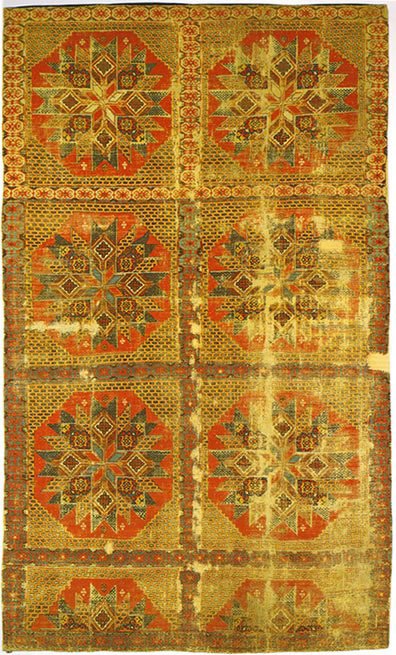
Spanish Carpet, possibly Alcaraz, 15th century, Metropolitan Museum, New York, (from V. Gantzhorn, Oriental Carpets, ill. 336).
Although they did not produce their own knotted pile carpets, Medieval Europeans were nonetheless attracted to the ones made by their Muslim competitors to the East. The admiring observations of the Venetian merchant Marco Polo on Anatolian carpet production in the thirteenth century were a harbinger of things to come.
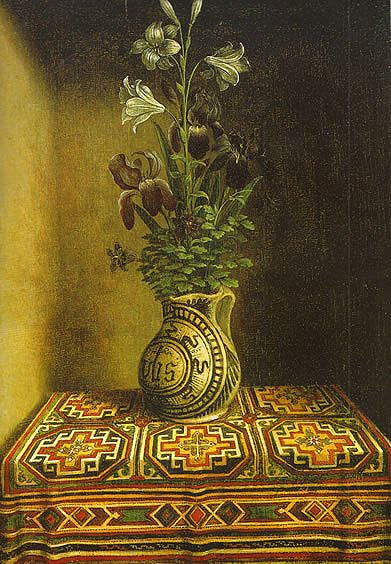
Depiction of a ‘Memling Gul’ rug in a still-life with a flower vase by Hans Memling, before 1494 (from V. Gantzhorn,Oriental Carpets, ill. 448).
As commerce between Europe and the Orient accelerated in the wake of the Crusades, Oriental carpets began to become less remarkable in the West. But what probably did the most to accelerate the European familiarity with Oriental carpets was the emergence of the Ottoman Dynasty, which initially established itself in the Balkan Peninsula and southeastern Europe before taking control of Anatolia and Western Asia.
Since carpets were an important aspect of Turkish material culture, the development of the Ottoman power in the Balkans and the regions to the north must have brought large numbers of carpets to the very doorstep of Central and Western Europe.
When we add to this the role of Venice as a major conduit between Europe and the East and the increase of intra-European commerce generally toward the end of the Middle Ages, it is hardly surprising that Europeans became avid collectors of Oriental carpets over the course of the fourteenth and fifteenth centuries, and in the two centuries that followed as well.
The European appetite for carpets is attested not only by extant pieces whose early arrival in Europe is historically documented, but also by European painting of the fourteenth and fifteenth centuries, and later as well. In truth, the depiction of early Turkish carpets in European master paintings, which can be closely dated, is the basis for Oriental carpet chronology, as well as for the descriptive terminology and classification in carpet scholarship.
Many of the terms or types mentioned above – Holbein, Memling, Crivelli, Lotto, Ghirlandaio, and others as well, are named for the European painters who depicted the carpets. In recent scholarship, John Mills has taken the study of early carpets from the perspective of European painting to new standards of critical analysis. Work of this kind has made it possible to form a much more thorough picture of early carpet production than would be possible purely on the basis of the actual pieces that survived.

Holbein Rug Painting
Depiction of a “Small Pattern Holbein rug” in a portrait of Georg Gisze by Hans Holbein the Younger, 1532 Gallery of Paintings, Berlin (from V. Gantzhorn, Oriental Carpets, ill. 14).
After the sixteenth century, commerce with the Orient began to introduce affluent Europeans to the carpets of Safavid Persia as well as those of Ottoman Turkey. Persian rugs appear commonly in the works of the great Dutch masters like Jan Vermeer

